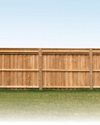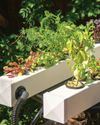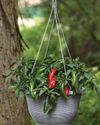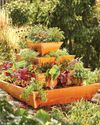A planter like this is super simple to build. And it’ll last a long, long time because there’s no soil-to-wood contact—and therefore no rot.

Instead, the soil is contained in a plastic planter inside the wooden planter. The only part that touches the ground is never-rust aluminum. You’ll find everything you need for this project at a home center.
1 FIGURE OUT THE LENGTH OF YOUR SIDEBOARDS
Lay out the liners, decking boards and a 1/4-in. shim to establish the length of the side boards.
2 ESTABLISH THE LENGTH OF THE END BOARDS
Measure a liner plus a 1/4-in. shim to determine the length of the end boards (Photo 3). Cut eight boards of each length and apply finish to all four sides and the ends.
3 ASSEMBLE THE PLANTER RINGS
Clamp and screw together each ring of deck boards with two2-in. exterior screws. Choose the best-looking board sides to face outward.
Choose your plastic planters first
The plastic planters (called “liners” from here on) determine the shape and size of the planter boxes, so shop for those first. Choose ones with sturdy plastic lips that can support the weight of the plants and soil. Your planter shapes can range from square to long, narrow rectangles; it all depends on the liner sizes and how you decide to configure them. You can adjust the height of your planters simply by using more or fewer rings of decking boards (Photo 4). But if you make your planters shorter, be sure the liners will clear the ground when they’re in place.
Buying the materials
We built our planters from 5/4x6 cedar decking (1 in. thick and 5-1/2 in. wide), the standard dimensions for decking. If you plan to stain your planters, you can save 30 to 40 bucks by substituting treated decking boards. If your planters will rest on a composite deck, you may want to choose matching or contrasting composite decking.
This story is from the June 2019 edition of Family Handyman.
Start your 7-day Magzter GOLD free trial to access thousands of curated premium stories, and 9,000+ magazines and newspapers.
Already a subscriber ? Sign In
This story is from the June 2019 edition of Family Handyman.
Start your 7-day Magzter GOLD free trial to access thousands of curated premium stories, and 9,000+ magazines and newspapers.
Already a subscriber? Sign In

7 Bicycle Maintenance Tips
Keep your bike in tiptop shape and ride safe!

SETTING FENCE POSTS WITH EXPANDING FOAM
Any fence builder knows you need strong posts for a strong fence, and that means backfilling the postholes with a dense, hard material other than dirt.

PEBBLE MOSAIC STEPPING STONES
COLLECT SOME RIVER ROCK AND MAKE YOUR OWN UNIQUE STEPPINGSTONE PATH

EARTH-FRIENDLY WEED KILLERS
HEALTHIER CHOICES FOR HUMANS AND THE ENVIRONMENT

DIY! HYDROPONIC GARDEN
FRESH VEGETABLES AT YOUR FINGERTIPS

GROW MINI VEGETABLES
GROW A GARDEN IN A TINY SPACE!

BUILD A VERTICAL GARDEN
TIME TO GROW UP!

MODERN WATER FOUNTAINS
A SPLASH OF PEACE FOR YOUR PATIO

9 ALTERNATIVE USES FOR SAWDUST
Every fully stocked wood shop has a table saw. You can usually find a pile of sawdust under it, even if it's used only occasionally. If a shop has a belt sander or band saw, there's probably another pile of finer sawdust under that. Even people without stationary tools have sawdust accumulation on their workbenches.

INSULATE WITH FOAM
IT'S A GREAT ALTERNATIVE TO FIBERGLASS